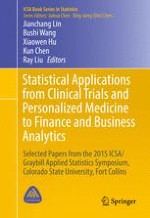2016 | Book
Statistical Applications from Clinical Trials and Personalized Medicine to Finance and Business Analytics
Selected Papers from the 2015 ICSA/Graybill Applied Statistics Symposium, Colorado State University, Fort Collins
Editors: Jianchang Lin, Bushi Wang, Xiaowen Hu, Kun Chen, Ray Liu
Publisher: Springer International Publishing
Book Series : ICSA Book Series in Statistics
